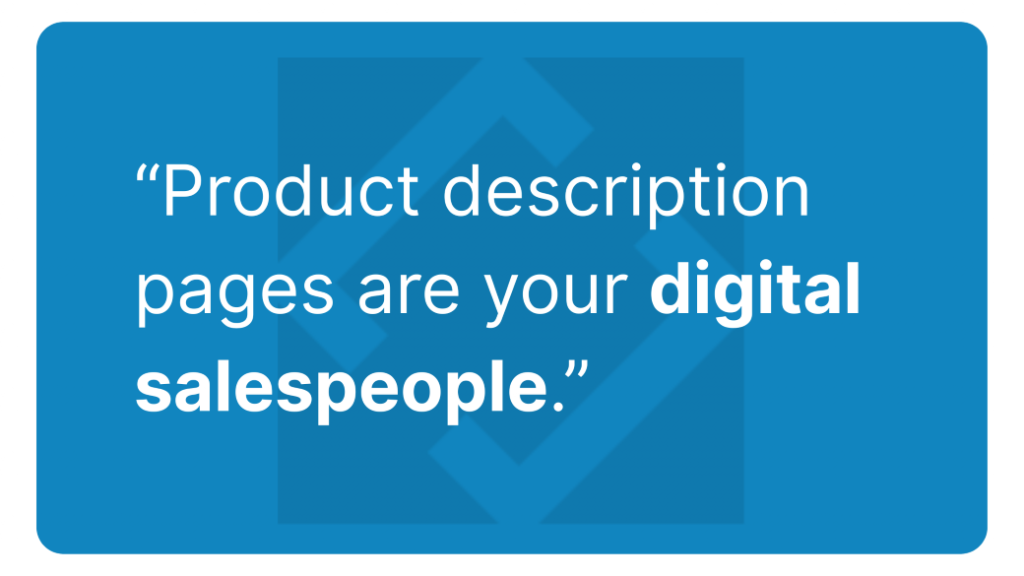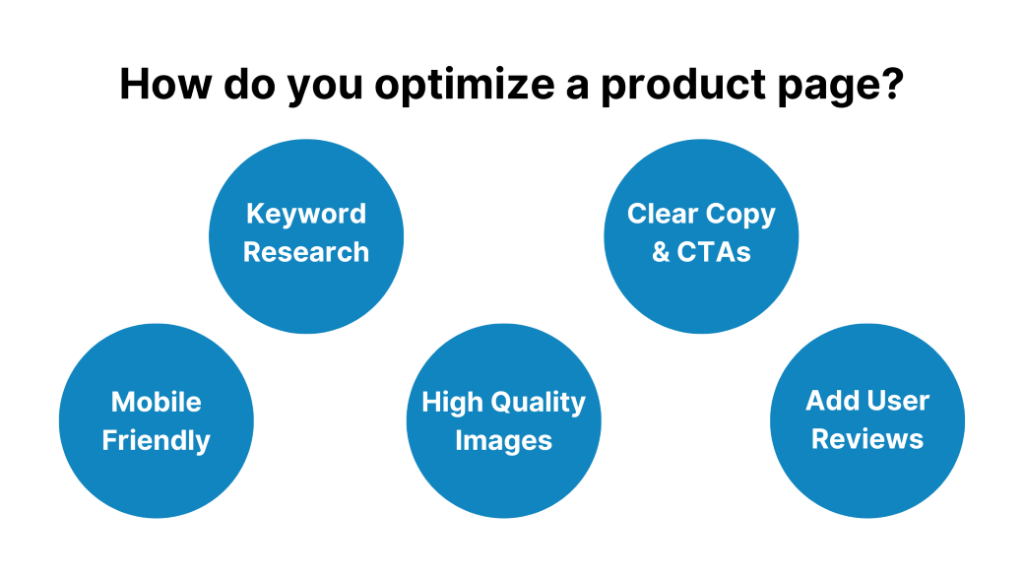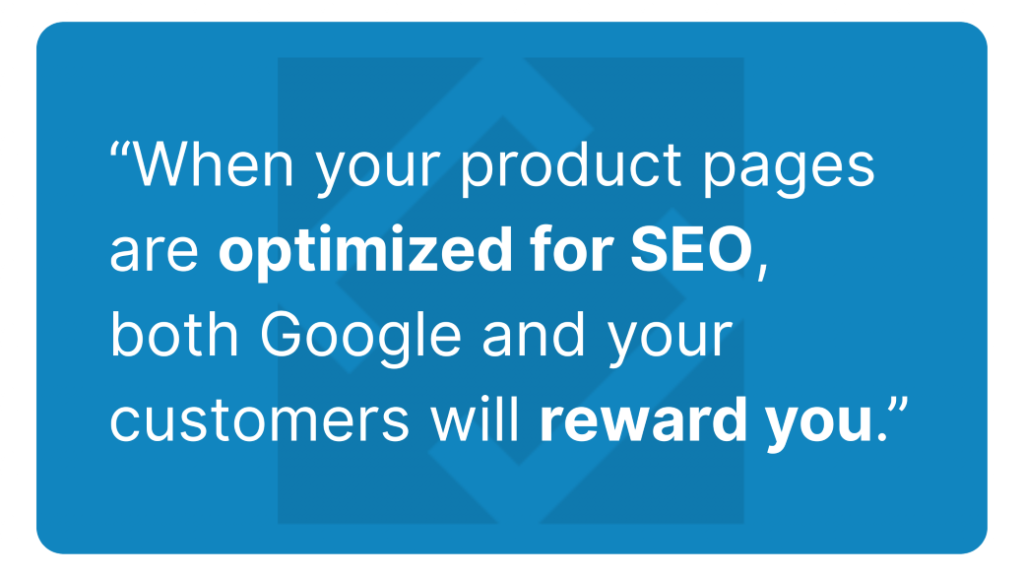- Product description pages are critical to ecommerce because they’re the part of your website that convinces customers to buy. Think of them as digital salespeople.
- Research keywords first. Use relevant short-tail, long-tail, and related terms naturally throughout the page.
- Make your copy clear, benefit-focused, and easy to scan. Use strong CTAs.
- Always optimize for mobile. Use responsive design, fast load times, and clean layouts.
- Include quality images. Show multiple views and add alt text for SEO and accessibility.
- Regularly update your product description pages based on trends, feedback, and testing, as well as changes to your product line and inventory.
Product description pages are a vital part of ecommerce. They’re more than just a place to dump random product information and photos. Product description pages are essentially your digital salespeople, enticing consumers with all the features that make your product special. They’re the hard-working pages that convince someone to click “Add to Cart” or “Buy Now.”
But here’s the hard truth. Even if your product is amazing, people won’t find it or buy it online unless your pages are optimized for both search engines and shoppers. That’s where being smart about SEO comes in.
This guide is packed with proven tips to turn your product pages into high-performing powerhouses. We’ll cover SEO best practices, writing hacks, and design tips to make your products irresistible and rank-worthy.

1. Start with strategic keyword research
Let’s kick it off with the basics. SEO starts with knowing what people are searching for.
Before you write a single word of your product description, do keyword research to figure out what exact phrases your audience uses. You’ll want to focus on:
- Primary keywords (also known as short-tail keywords”: e.g. “organic cotton T-shirt”
- Long-tail keywords: e.g. “women’s organic cotton T-shirt with scoop neck”
- LSI (Latent Semantic Indexing) keywords: e.g. “eco-friendly shirt”, “sustainable fashion”, “soft breathable fabric”
Not sure where to get started with keyword research? Use tools like:
Pro Tip: Don’t stuff your product page with keywords. Your customers (and Google) will hate it. Instead, work them in naturally to your product title, headers, meta description, and throughout the product page copy.
2. Write clean, persuasive copy
What makes a good product description? The best ones accomplish three things:
- Great pages explain what the product is
- The copy highlight its benefits
- They persuade the customer to buy
That’s a tall order, but it’s doable when your copy is concise and human-friendly. To make sure your product description copy pops off the page and entices the reader to buy, follow these tips:
- Don’t write a wall of text. Break your descriptions up into short, punchy paragraphs and bullet points or numbered lists.
- Use familiar sensory and emotional language (e.g., “ultra-soft,” “flattering fit,” “designed for everyday confidence.”)
- Answer any potential objections and questions your customer may have, before they even ask. “Yes, this water bottle is dishwasher-safe!”
- Avoid jargon. You’re not writing a tech manual, so keep it approachable and not too niche.
Important information to include:
- What your product is
- How to use it
- Who your product is for
- Materials or ingredients
- Sizing/dimensions
- Shipping details
- Warranty or return policy
And always, always, always proofread.
3. Make pages mobile-friendly and fast
Over half of all online shopping happens on a mobile device. If your product pages aren’t optimized for mobile, you’re losing sales.
Here’s how to build a mobile-friendly, streamlined UX:
- Use a responsive design that looks great on all screen sizes
- Keep buttons big and tappable
- Make sure product images are swipe-friendly
- Use collapsible sections (accordion style) for long descriptions
- Minimize clutter and simplify the layout as much as possible
- Optimize loading speed (compress your images and use fast hosting)
Not sure if your page meets all these requirements? We recommend testing it for mobile friendliness with Google’s Mobile-Friendly Test tool.
4. Include a clear, compelling CTA
You’ve done all this work to grab someone’s attention, now don’t let them hesitate. As the old saying goes, “He (or she) who hesitates, is lost.”
Your CTA (call to action) should be crystal-clear, confident, and easy to find. “Add to Cart” is fine, but here are some ways to spice it up:
- “Get Yours Today”
- “Grab It Before It’s Gone”
- “Yes, I Want This!”
- “Try It Risk-Free”
Use bright, contrasting buttons that stand out (but just don’t go neon unless it fits your brand).
Also, consider secondary CTAs for people who aren’t ready to buy:
- “Save for Later”
- “Add to Your List”
- “Join the Waitlist”
- “Ask us a Question”
A smaller, secondary CTA will keep consumers engaged even if they’re not quite ready to buy. This also gives you an opportunity to retarget them with special offers or email campaigns later.
5. Use high-quality product images (with alt text)
They say a picture is worth a thousand words, and product photos are no different. In fact, your product images are a huge conversion factor. Your customer can’t touch or try your item, so your images need to do that work for them.
The images on your product page can make or break your conversion rate, so follow these best practices:
- Use high-resolution images
- Show the product from multiple angles
- Include lifestyle images (product in use)
- Add zoom functionality
- Consider 360-degree or short video clips
Pro Tip: Don’t forget alt text! This helps search engines understand your images and can boost your page in image searches. Plus, it’s important for accessibility tools like screen readers.
Make sure your alt text:
- Describes the image clearly
- Includes a keyword (if relevant)
- Avoids keyword stuffing
Example: “Close-up of blue waterproof hiking backpack with padded straps”

6. Craft unique meta titles and descriptions
Your meta title and meta description are what show up on Google’s search results pages (also known as SERPs). So make them count! Use clear, concise language and include a CTA.
- Meta Title (50-60 characters max): Put the product name + a benefit
Example: “Sleek Stainless Steel French Press – Brew Bold Flavor” - Meta Description (160 characters max): Summarize the top selling points
Example: “This stylish 36oz French press delivers bold, smooth coffee. Dishwasher-safe and made to last. Shop now for free shipping.”
Use a tool like Higher Visibility’s SERP Snippet Optimization to preview how your metadata will appear in search results.
7. Get user reviews to display on your page
User reviews are the digital equivalent of a word-of-mouth recommendation. They’re one of the most powerful tools in digital ecommerce marketing. Also known as “social proof,” positive user reviews are often the final factor that convinces someone to buy your product.
Product reviews can:
- Increase trust
- Improve SEO (they add fresh, keyword-rich content)
- Reduce buyer hesitation
Use a plugin or app (like WP Business reviews, Fera, Yotpo, or Judge.me) to collect and display product reviews. If you can, add a review schema markup so stars appear in Google listings.
8. Use internal linking to boost SEO juice
Link to related products, blog posts, or helpful guides from your product pages. This does two things:
- Keeps users on your site longer (best for engagement and conversion)
- Helps search engines crawl your site better
Examples:
- “Pair it with our Bamboo Leggings”
- “See our full line of organic skincare”
- “Need help picking a size? Check out our sizing guide”
Just don’t overdo it. Always keep the links relevant and helpful, not spammy.
9. Don’t “set it and forget it”
Like most things in digital marketing, your product description pages aren’t “one and done.” You’ll need to periodically review your conversion rates and update your pages based on:
- New keywords and trends
- Customer feedback
- Inventory changes
- Updated features or specs
We also recommend regularly A/B testing different elements like:
- Different headlines
- CTA button colors or wording
- Long vs. short descriptions
- Lifestyle images vs. product-only shots
What works today might tank tomorrow, so stay flexible and make changes as needed!

Good SEO is good UX
At the end of the day, optimizing your product description pages isn’t about gaming Google. It’s about creating a better experience for real people. When your product pages are helpful, fast, persuasive, and easy to use, both Google and your customers will reward you.
Your product pages are like your digital storefront windows, so make them shine.
Want help writing killer product descriptions or auditing your product pages for SEO? Let’s talk! Let Redefine Marketing Group help you turn browsers into buyers. Contact us today to get started.





